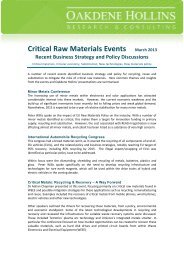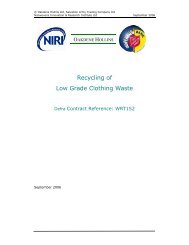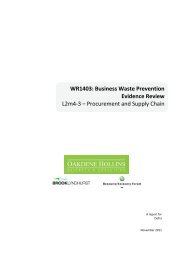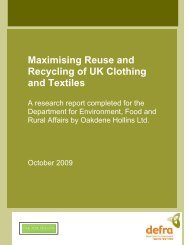Fire Retardant Technologies: safe products with ... - Oakdene Hollins
Fire Retardant Technologies: safe products with ... - Oakdene Hollins
Fire Retardant Technologies: safe products with ... - Oakdene Hollins
- No tags were found...
You also want an ePaper? Increase the reach of your titles
YUMPU automatically turns print PDFs into web optimized ePapers that Google loves.
European countries, <strong>with</strong> some niche exceptions, rely upon the General Product SafetyDirective.The UK also has robust nightwear <strong>safe</strong>ty regulations and test methods in place and theNetherlands has adopted this. Some other European countries seek to prohibit highlyflammable nightwear and related textiles but others rely on the General Product SafetyDirective (GPSD).The UK, along <strong>with</strong> other member states in Europe rely on the GPSD and industry voluntarymeasures for the fire <strong>safe</strong>ty of electronic <strong>products</strong>.The GPSD acts as a <strong>safe</strong>ty net to prevent the placing on the European market of dangerous<strong>products</strong> <strong>with</strong>in the scope of the directive, and particularly,a) where there are no specific <strong>safe</strong>ty regulations in place covering those <strong>products</strong>;b) where those <strong>products</strong> do not comply <strong>with</strong> national <strong>safe</strong>ty regulations; orc) which, even if they do comply <strong>with</strong> national <strong>safe</strong>ty regulations, are neverthelessconsidered to be dangerous.The need for further attention to fire <strong>safe</strong>ty in the GPSD has been acknowledged in a reportfrom the European Commission to the European Parliament and Council on theimplementation of the GPSD 9 .Approaches to Achieving <strong>Fire</strong> SafetyWhere fire <strong>safe</strong>ty standards exist in regulatory and legislative instruments and in Europeanand International standards, there is no requirement to use chemical FR technologies; anytechnology may be used as all standards are fire performance related. There are a varietyof chemical, materials and physical technologies that can enhance the fire performance of<strong>products</strong> in addition to the use of design approaches which may avoid the use of chemicalFRs. These technologies are reviewed and their relative environmental performanceconsidered in Annexe 3 – they include:1. Chemical fire retardants which are incorporated into thermoplastic and thermosettingpolymeric materials and fibres as either additive or reactive technologies. These mayoperate as fire and flame retardants in the gas phase inhibiting or quenching firedevelopment or as fire retardants in the solid phase by containing or restricting theavailability of fuel to the fire arising from the decomposing polymer. Examples includebrominated FRs which may be further enhanced using a synergist such as antimonytrioxide forming an FR system that is very effective in the gas phase, or anorganophosphorous FR that may operate mainly in the solid phase by encouragingchar formation. Examples of these are shown in Tables 1 and 2 of Appendix A.It is important to note that chemical FRs may be physically or chemically bound intoor onto the polymer material or fibre of interest and this will generally influence their9 Report from the EC to the European Parliament and Council on the implementation of theGPSD (2001/95/EC),http://ec.europa.eu/consumers/<strong>safe</strong>ty/prod_legis/docs/report_impl_gpsd_en.pdfP a g e 8 |









